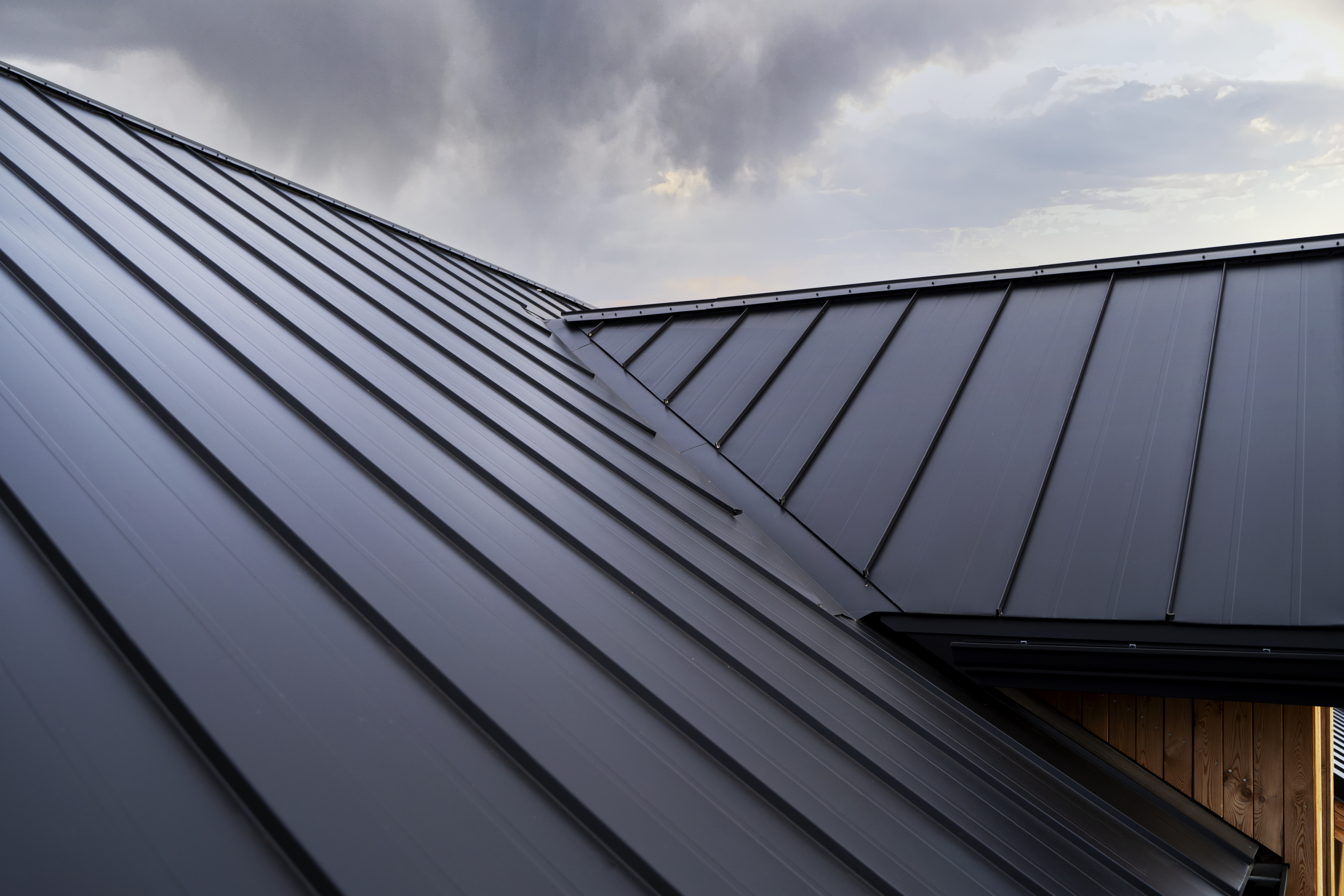
Lightning Protection for Metal Roofs – Do You Really Need It?
When discussing roofing, particularly metal roofs, the question of lightning protection often arises. The sight of a sleek, metallic surface might intuitively suggest a higher risk of lightning strikes. However, the reality of lightning risk & roofing conductivity for metal roofs is quite different from common perception, leading to an important discussion about whether you truly need a lightning rod with a metal roof. While metal roofs are excellent conductors, this quality, surprisingly, can be an advantage, though additional lightning protection might still be a prudent investment in certain circumstances.
Lightning risk & Roofing conductivity
Understanding how lightning interacts with metal roofs is crucial to dispelling common myths.
Do Metal Roofs Attract Lightning? No.
Extensive research and data from organizations like the National Weather Service (NWS) and the Metal Construction Association confirm that metal roofs do not attract lightning any more or less than other roofing materials like asphalt shingles, tile, or wood.
Lightning strikes are primarily determined by factors such as a building's height, shape, and isolation within its surrounding environment. A tall, isolated structure on a hill is at higher risk of a strike regardless of its roofing material.
Metal as a Conductor: An Advantage, Not a Disadvantage:
While metal is an excellent electrical conductor, this is actually beneficial in the event of a lightning strike.
Instead of concentrating the lightning's immense energy at a single point (which can happen with non-conductive materials like asphalt, leading to fires or explosive damage), a metal roof allows the electrical charge to disperse rapidly across its entire surface.
This spreading of energy reduces the likelihood of localized hot spots, which are the main cause of fires from lightning strikes.
Fire Resistance: Metal roofs have a Class A fire rating, meaning they are non-combustible and will not ignite from a lightning strike, significantly reducing the risk of a roof fire.
Conclusion: A metal roof itself does not increase the likelihood of a lightning strike. In fact, if a strike does occur, a properly grounded metal roof can help dissipate the electrical energy safely, potentially making it a safer roofing material than others prone to combustion.
When lightning protection is necessary
Despite the inherent advantages of a metal roof during a lightning strike, there are specific scenarios where a dedicated Lightning Protection System (LPS) is still highly recommended or even essential.
Height and Isolation: If your home is one of the tallest structures in the area, or is isolated on a hilltop or in an open field, it has an increased risk of being struck, regardless of the roof material. An LPS provides a controlled path for the lightning.
High Lightning Activity Areas: If you live in a region with frequent and severe thunderstorms (e.g., certain areas of Florida, the Midwest, or parts of the Gulf Coast in the U.S.), the overall risk of a strike to any structure is higher, making an LPS a wise investment.
Presence of Sensitive Electronics: Lightning strikes can cause massive power surges, even if they don't directly hit the building. If your home contains valuable or sensitive electronic equipment, an LPS combined with surge protection devices (SPDs) can safeguard these assets.
Structures with Flammable Contents: While less common for residential, if a structure contains highly flammable materials, a comprehensive LPS is critical.
Building Code Requirements: In some jurisdictions or for certain building types (e.g., hospitals, schools, public buildings), local building codes may mandate lightning protection regardless of roof material.
Peace of Mind: For many homeowners, the ultimate protection and peace of mind offered by a complete LPS outweighs the additional cost, even with a metal roof.
Installation of lightning rods & grounding
A comprehensive Lightning Protection System (LPS) is a sophisticated network, not just a single rod. Installation must adhere to strict safety standards like NFPA 780 (Standard for the Installation of Lightning Protection Systems) and UL 96A.
Components of an LPS:
Air Terminals (Lightning Rods): These are pointed or blunt metallic rods (typically copper or aluminum) installed at the highest points of the roof and along ridges at specified intervals. Their purpose is to intercept a lightning strike.
Main Conductors (Down Conductors): Heavy-gauge copper or aluminum cables connect the air terminals to the grounding system, providing a low-resistance path for the lightning current. These are run discreetly down the sides of the building.
Grounding Electrodes (Ground Rods/Plates): Buried deep into the earth (typically 10-foot long copper-clad steel rods), these components safely dissipate the lightning's immense electrical energy into the ground. Multiple ground rods are usually interconnected.
Bonding: All major metallic elements of the building (e.g., metal roof panels, vent pipes, HVAC units, metal siding, plumbing systems, electrical conduits) must be bonded (electrically connected) to the lightning protection system. This prevents "side flashes," where lightning jumps from the LPS to another metal object, potentially causing damage or fire.
Surge Protection Devices (SPDs): Installed at main electrical panels and sensitive equipment, SPDs protect against internal surges that can occur from nearby lightning strikes or the discharge of a direct strike.
Installation on Metal Roofs:
Non-Penetrating Attachments: For standing seam metal roofs, specialized non-penetrating clamps are often used to attach air terminals and conductors to the seams without drilling holes through the roof panels. This preserves the roof's watertight integrity and allows for thermal movement of the panels.
Penetrating Attachments (Less Common): If penetration is necessary for certain roof types or components, it must be properly sealed with watertight flashing (e.g., EPDM rubber boots with aluminum flanges) to prevent leaks.
Material Compatibility: Care must be taken to use compatible metals (e.g., aluminum conductors with aluminum roofs; copper with copper roofs) to avoid galvanic corrosion.
Certified Installers: It is absolutely critical to have an LPS installed by a certified lightning protection specialist (e.g., by the Lightning Protection Institute - LPI). This ensures adherence to complex standards and proper system functionality.
Local code requirements & insurance implications
The decision to install an LPS can be influenced by local regulations and may offer financial incentives.
Local Code Requirements:
While not universally mandated for all residential homes, some local building codes, especially in high-risk areas or for specific building types (e.g., schools, hospitals, large commercial structures), may require a lightning protection system.
It's always best to check with your local Authority Having Jurisdiction (AHJ) or building department before installation.
Compliance with national standards like NFPA 780 and UL 96A is often a requirement when an LPS is installed.
Insurance Implications:
Reduced Premiums: Many homeowners and commercial property insurance providers offer discounts or credits on premiums (typically 5% to 15%) for properties with a professionally installed and certified lightning protection system. Insurers recognize that an LPS significantly reduces the risk of costly fire damage, structural damage, and destruction of electronic equipment.
Faster Claim Processing: In the unfortunate event of a lightning strike, having a certified LPS can often lead to smoother and faster claim processing, as it demonstrates proactive risk mitigation.
Claim Denial Prevention: While standard policies usually cover lightning damage, having an LPS in place reinforces your commitment to property protection and can potentially prevent disputes over negligence.
Increased Property Value: A certified LPS can be an attractive feature for potential buyers, contributing to the perceived safety and overall value of your home.
Maintenance and inspection advice
Even after a lightning protection system is installed, ongoing maintenance and periodic inspections are crucial to ensure its continued effectiveness.
Annual Visual Inspection:
Walk around the property (safely from the ground or using professional access) to look for any visible damage to air terminals, conductors, or ground connections.
Check for loose or corroded connections, damaged cables, or changes to the grounding area (e.g., soil erosion exposing ground rods).
Professional Inspection:
It is highly recommended to have a certified lightning protection professional inspect your system every 3-5 years, or immediately after a known lightning strike to your property or a major roof alteration (like a re-roofing project or adding a new structure to the roof).
These professionals can perform continuity tests, measure ground resistance, and ensure all components meet NFPA 780 and UL 96A standards.
Repair Promptly: Any identified damage, no matter how minor, should be repaired immediately by a qualified professional to maintain the system's integrity. A compromised section can render the entire system ineffective.
Keep Records: Maintain records of all installations, inspections, and repairs for warranty purposes and potential insurance claims.
While a metal roof does not inherently attract lightning, its excellent conductivity makes it a safer material in the event of a strike by dispersing the energy. However, for ultimate protection, especially on tall or isolated structures, or in lightning-prone areas, a professionally installed and maintained Lightning Protection System is an invaluable investment. It safeguards your home, its contents, and provides unparalleled peace of mind. Masterpiece Roofing works with certified lightning protection specialists to ensure your roof system is not only beautiful and durable but also comprehensively protected.
Ready to enhance the safety and protection of your metal roof? Contact Masterpiece Roofing today for a comprehensive consultation on lightning protection and a detailed estimate.
Office: 1248 Highland St, Holliston, 01746 MA
(508) 882-6080
Email: office@buttonmasterpieceroof.com
Site: www.masterpieceroof.com
Assistance Hours
Mon – Fri 8:00am – 4:00pm

